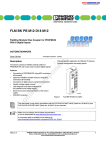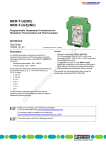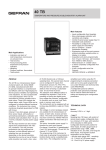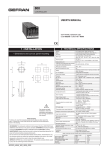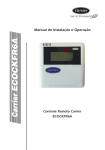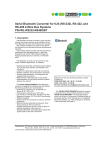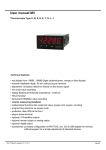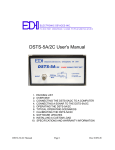Download Manual
Transcript
MCR-T-UI(-E)... MCR Temperature Measuring Transducer 1. Description A universal temperature measuring transducer for resistance thermometers and thermocouples, with freely selectable temperature range, is available for the MCR-T converters (resistance thermometer: -200°C to 850°C [-328˚F to +1562˚F]), thermocouple sensors: -200°C to 2300°C [-328˚F to +4172˚F]). The analog standard signals 0(4)…20 mA, 0…10 V, ±10 V, 0(1)…5 V, ±5 V can be used with normal (e.g., 0…10 V) and inverse (e.g., 10…0 V) action on the output side. A PNP transistor switching output (100 mA) with two switching points and 8 switching functions provides an additional monitoring function. 1.1. Versions • With standard configuration - MCR-T-UI(-E)/NC (PT100 DIN IEC 751 3-wire from -200…850°C (-328˚F… 1562˚F) with 4…20 mA output and disabled switching output) • With project-specific configuration - MCR-T-UI(-E) The configuration should be specified in the order key (see Page 5). Upon delivery the module is configured according to user requirements and therefore ready to operate. • The modules can be parameterized freely using the configuration kit MCR-CONF-WIN or MCR/PICONF-WIN. 1.2. Input The following sensor types and input signals can be processed on the input side: • Resistance thermometers in 2, 3 or 4-wire version • Thermocouple sensors • Thermocouple sensors of the same type connected in series for measuring temperature differentials • mV voltages from -20 mV to +2400 mV • Linear resistors in the range from 0 Ω to 8000 Ω • Potentiometers up to 8 kΩ 1.3. Output The MCR-T… has two outputs: • Analog output with either 0(4)…20 mA or 0…10 V, ±10 V, 0(1)…5 V, ±5 V with normal or inverse action (e.g., 0...10 V /10…0 V). The loads must not fall below a voltage output of 10 kΩ and must not exceed a current output of 500 Ω. • PNP transistor switching output (100 mA) without free-wheeling diode but with suppressor diode for transient protection. The configuration kit MCR-CONF-WIN... or MCR/PI-CONF-WIN is required to program this output. Headquarters: © Phoenix Contact GmbH & Co. KG • Flachsmarktstraße 8 • 32825 Blomberg • Germany Phone +49-(0) 52 35-3-00 • Fax +49-(0) 52 35-3-4 12 00 • www.phoenixcontact.com Local Contact: www.phoenixcontact.com/salesnetwork MCR Temperature Measuring Transducer – MCR-T-UI(-E)... 2. Technical Data OUT + - 1 2 3 + - NC NC ϑ A D D µC 4 5 6 A 7 8 9 O UT I O UT U GND 0 ! " = = 114.5 IN + - (+) 24VDC SP (–) GND 99 MCR-T-UI(-E)/... with signal conversion: resistance thermometer and thermocouple/± 5 V; ± 10 V; 0(1)…5 V; 0…10 V; 0…20 mA; 4…20 mA 8 M3 fixed Connection data [mm2] 0.2-2.5 flexible Housing width 17.5 mm (0.689 in.) Aa AWG 0.2-2.5 24-14 Description MCR-T module, not configured, for thermocouple sensors and resistance thermometers, in 2, 3 or 4-wire technology 0…20 mA, 4…20 mA, 0(1)…5 V, 0…10 V, ± 5 V, ± 10 V (also inverse signals) MCR-T module, as above. Configured version 0…20 mA, 4…20 mA, 0…5 V, 0…10 V, 1...5 V, ± 5 V, ± 10 V MCR-T module, not configured, for thermocouple sensors and resistance thermometers, in 2, 3 or 4-wire technology, with electrical isolation of input/output and input/power supply MCR-T module, as above. Configured version 0…20 mA, 4…20 mA, 0(1)…5 V, 0…10 V, ± 5 V, ± 10 V (also inverse signals) 0…20 mA, 4…20 mA, 0…5 V, 0…10 V, 1...5 V, ± 5 V, ± 10 V Order No. MCR-T-UI/NC 28 14 10 0 1 MCR-T-UI 1) 28 14 09 0 1 MCR-T-UI-E/NC 28 14 12 6 1 MCR-T-UI-E 1) 28 14 11 3 1 1 ) Specify configuration! (See order example on the last page) Technical Data Input Input Supply current (resistance thermometer) Input protection Connection method Pcs. Pkt. Type Resistance thermometer in 2, 3 or 4-wire technology Thermocouple sensors (B, E, J, K, N, R, S, T, L, U, C, W, HK) Linear mV signals from - 20 mV to + 2400 mV 250 µA Transient protection, surge protection 30 V DC Plug-in screw-clamp connection Additional technical data can be found on page 3 PHOENIX CONTACT page 2 of 7 MCR Temperature Measuring Transducer – MCR-T-UI(-E)... Output Output signal Maximum output signal D/A resolution Load Ripple Open-circuit response Measuring range exceeded/not reached Output protection Switching output General Data Supply voltage Current consumption Transmission error Cold junction error Temperature coefficient Ambient temperature range Test voltage (only MCR-T-UI-E...) 0…20 mA 4…20 mA 0(1)…5 V 0…10 V ± 5 V ± 10 V 24 mA 24 mA ±12 V ±12 V ±12 V ± 12 V ± 12 bits ≤ 500 Ω ≤ 500 Ω ≥ 10 kΩ ≥ 10 kΩ ≥ 10 kΩ ≥ 10 kΩ < 20 mVpp From - 12 V to + 12 V or 0 mA to 24 mA From - 12 V to + 12 V or 0 mA to 24 mA Transient protection PNP transistor output, with a load capacity of 100 mA, switches supply voltage; disabled for project-specific configuration, otherwise can be freely programmed using MCR-CONF-WIN-... and MCR/PI-CONFWIN. Input/output Input/power supply Approbation c 18...30 V DC ≤ 60 mA ≤ 0.1% of the final value, + 6 mV or 12 µA at the output ≤ 3 K, typical 1.5 K ≤ 0.01%/K, typical 0.005%/K - 20°C to + 65°C (-4˚F to 149˚F) 1 kV, 50 Hz, 1 minute 1 kV, 50 Hz, 1 minute F Conforms to the EMC Directive 89/336/EEC and the Low Voltage Directive 73/23/EEC EMC (electromagnetic compatibility) Noise immunity according to 50082-2 • Electrostatic discharge (ESD) 8 kV air discharge2) 4 kV contact discharge2) EN 61000-4-2 • Electromagnetic HF field Amplitude modulation Pulse modulation EN 61000-4-3 • Fast transients (burst) EN 61000-4-4 Input/output/supply: 2 kV/5 kHz2) • Conducted interference EN 61000-4-6 Input/output/supply: 10 V1) Noise emission according to EN 50081-2 EN 55011 Class A EN 61000 corresponds to IEC 1000/ EN 55011 corresponds to CISPR22 These results were achieved using shielded cables. 1) 2) 10 V/m1) 10 V/m1) Criterion A: normal operating characteristics within the specified limits. Criterion B: temporary adverse effects on the operating characteristics which the device corrects itself. Class A: industrial application without special installation measures 1 6 O 4V P +2 I U R ND E G WP D S T GN U O I T/U RMC 2 r we Po de Mo 1 2 4 IN MCR-T-UI ... MCR Temperature Measuring Transducer N 3 C N C 1 Programming interface 1 0 I 4 09 T/U 1 R- : 28 MC.-Nr. Art 7 T OU 2 3 8 2 Plug-in screw-clamp terminals (COMBICON) D A 3 3 Shield connection (on terminal 5 or 6) 5 IN 6 ϑ 2 = 4 5 6 4 Metal lock for fastening on the DIN rail 1 2 3 6 Error LED 11 12 D 1 3 5 Plug-in screw-clamp terminals (COMBICON) 9 10 µC 4 4 . / N.C N . NE N.C ATIO 6 OB PR AP = 7 I 8 T OU U T 9 OU 10 D DC GN V 11 4 +2 12 SP D GN LS A OV PR AP 5 4 PHOENIX CONTACT page 3 of 7 5 MCR Temperature Measuring Transducer – MCR-T-UI(-E)... 3. Method of Operation The analog input signal of the temperature sensor is digitized with a 24-bit resolution and then supplied to a microcontroller. The microcontroller forms a digital output value in line with the temperature from the input signal. This is supplied via optocouplers to a D/A converter after electrical isolation. The corresponding output signals are realized using a subsequent voltage or current level (e.g., 0…10 V, 0…20 mA). The microcontroller has an integrated memory in which the program sequence for the measured value calculation is stored. The user-specific parameters are stored in an EEPROM (electrically erasable programmable read-only memory). The programmed data remains in the memory even after the supply voltage has been disconnected. 4. Connections 4.1. Thermocouple Sensors • Simple temperature measurement For temperature measurement using the thermocouple sensors described on page 5, the terminal points 1 and 2 of the MCR-T should be connected taking into consideration the polarity of the sensor. (1 = "+" input; 2 = "–" input) • Differential temperature measurement To measure temperature differentials with only one temperature measurement converter, the MCR-T… offers the option of connecting two thermocouple sensors of the same type in series and laying the two remaining branches to terminal points 1 and 2. The connection ends of the two thermocouple sensors can be fixed to terminal points 5 and 6 (see corresponding circuit diagram). The differential temperature measurement can only be set using the configuration software MCR-CONFWIN… or MCR/PI-CONF-WIN because the internal cold junction compensation must be switched off for this. 4.2. Resistance Thermometer For temperature measurement using the resistance thermometers described on page 5, the terminal points must be connected according to the wire connection method (see corresponding circuit diagram); 1 and 3 for 2-wire, 1, 2 and 3 for 3-wire and 1, 2, 3 and 4 for 4-wire technology. 4.5. Evaluation of Potentiometer Settings To evaluate potentiometers up to 8 kΩ, terminals 1 and 3 are connected with the external cables and terminal 2 is connected 2 with the loop cable. 4.6. Switching Output The PNP transistor switching output switches the supply voltage UB when the programmed switching conditions are met from 24 V on terminal !. The transistor output should only be loaded with a maximum of 100 mA. A suppressor diode protects this output from fast transients. 5. Error Detection: Open Circuit/Measuring Range Exceeded or Not Reached Display of open circuit/measuring range exceeded or not reached for project-specific configured modules: • The red MODE LED is permanently on. • The following voltages and currents can be measured at the output using the selected output signal configuration: Output Signal at Output Signal Open Circuit Measuring Range Exceeded/ Not Reached 0...5 V; ±5 V 0...10 V; ±10 V 0...20 mA 4...20 mA 5.5 V 11 V 22 mA 22 mA 5.25 V 10.5 V 21 mA 21 mA During independent configuration, values between -12…+12 V and 0…24 mA can be set freely. 6. Changing the Configuration Data To change the configuration data, use the configuration kit MCR-CONF-WIN… or MCR/PICONF-WIN. An additional User Manual and online help for the software provide a more detailed explanation of the configuration options and how to carry them out. The adapter cable MCR-TTL/RS232-E should be used to connect the module and the PC. This is not contained in the configuration kit. 4.3. Measurement of mV Voltages Voltages in the range from -20…+2400 mV are measured at terminal points 1 and 2, where 1 is the "+" input and 2 is the "–" input. 4.4. Measurement of Resistance To measure differing resistance between 0…8000 Ω, terminal points 1 and 3 are used. The connection is made using 2-wire technology. PHOENIX CONTACT page 4 of 7 MCR Temperature Measuring Transducer – MCR-T-UI(-E)... 7. Order Key for the Programmable Temperature Measuring Transducer Resistance Thermometer Thermocoup es (Temperature Ranges According to IEC 751/EN 60 751 and DIN 43 760 SAMA RC 21-4-1966 in 2, 3 or 4-Wire Version) Sensor Type 1) Measuring Range Standard Minimum Measuring Range Span Pt sensors Ni sensors Cu sensors Ni 1000 Cu 50 Cu 53 KTY 81-110 -200°C...850°C -60°C...180°C -70°C...500°C -50°C...160°C -50°C...200°C -50°C...180°C -55°C...150°C (DIN/SAMA) (DIN/SAMA) (SAMA) (Landis & Gyr) – – (Philips) 0.4 K 0.4 K 0.4 K 0.4 K 0.4 K 0.4 K 0.4 K 1 Sensor Type 1 ) Thermocouple Measuring Range Minimum Measuring Range Span U 2) T 2) L 2) J 2) E 2) K 2) N 2) S 2) R 2) B 2) Cu-CuNi Cu-CuNi Fe-CuNi Fe-CuNi NiCr-CuNi NiCr-Ni NiCrSi-NiSi Pt10Rh-Pt Pt13Rh-Pt Pt30RhPt6Rh -200°C...600°C -200°C...400°C -200°C...900°C -210°C...1200°C -226°C...900°C -200°C...1372°C -200°C...1300°C -50°C...1768°C -50°C...1768°C 500°C...1820°C >1K >1K >1K >1K >1K >1K >1K >4K >4K > 10 K -18°C...2316°C -18°C...2316°C -200°C...800°C >4K >4K >1K C W HK ) Additional types or characteristics on request. Equation to convert temperatures from°C to °F: 9 T [°F] = – T [°C] + 32 5 2 ) Thermocouples according to IEC 584/EN 60584 Resistors, Potentiometers, mV Vo tages Input Measuring Range Order Minimum Reference Measuring Range Span Resistor 0 Ω … 8000 Ω (2-wire) RES 2Ω Potentiometer (max. 8 kΩ) 0 … 100% (3-wire) POT 0.2% Voltage -20 mV …+2400 mV VOL 2 mV Order Key for MCR-T-UI-E (Order No. 28 14 11 3) and MCR-T-UI (Order No. 28 14 09 0) The standard configuration will be supplied if customer order details are incorrect or not provided. Sensor Type Characteristic Connection Measuring Standard configuration: MCR-T-UI-E / PT100 / D / 3 See tables above under "Sensor Type" and "Order Reference" D = DIN S = SAMA (see above table) 0 = for thermocouple, resistor, potentiometer, voltage, Ni1000 (Landis&Gyr)Cu 10, KTY 81-110, Cu50, Cu53 Measuring Unit Output 1 / 2 1 =°C 2 = °F 3 = mV 4=Ω 5=% 0 = 0…10 V 1=0…5V 2 = 0…20 mA 3 = 4…20 mA 4 = -10…+10 V 5 = -5 … +5 V / -200.0 2 = 2-wire 3 = 3-wire 4 = 4-wire 0 = for thermocouple, resistor, potentiometer, voltage, Start value at 0 mA (e.g., -200.0°C [-328˚F]) Output Characteristic / 1 1 = normal 2 = inverse PHOENIX CONTACT page 5 of 7 / +850.0 Final value at 20 mA (e.g., +850.0°C [+1562˚F) / MCR Temperature Measuring Transducer – MCR-T-UI(-E)... Order Examples for MCR-T-UI(-E) With Different Input Versions: Resistance Thermometer MCR-T-UI-E / PT100 / D 3 / -200.0 / +850.0 / 1 / 3 / 1 (Configuration for 3-wire PT100 sensor: according to DIN of -200.0°C to +850.0°C with 4…20 mA output characteristic) Thermocouple MCR-T-UI-E / J / 0 / 0 / -346 / +2192 / 2 / 3 / 2 (Configuration for thermocouple Type J from -346°F to +2192°F with 20…4 mA output characteristic) Voltage MCR-T-UI-E / VOL / 0 / 0 / -10 / 1200 / 3 / 0 / 2 (Configuration for voltage input from -10 mV to +1200 mV with 10…0 V output characteristic) Resistor (2-wire connection) MCR-T-UI-E / RES / 0 / 0 / 0 / 7500 / 4 / 1 1 (Configuration to connect a resistor that varies between 0 Ω and 7500 Ω. The output signal is 0…5 V.) Potentiometer (3-wire connection) MCR-T-UI-E / POT / 0 / 0 / 10 / 90 / 5 / 3 / 1 (Configuration for connecting a 3-wire potentiometer, where 10 - 90% of the range is used. The output is 4…20 mA.) 8. Application Example Temperature monitoring with a PT100 element in 2-wire technology when using the transistor switching output 50°C PT 100 0° C 0° C 10 Cooler IN 1 4 6 NC 3 Pow er 2 OUT M CR - T - UI - E Mode 5 NC POWER I 7 U 8 GND 9 + 24V SP GND 0 ! " Alarm 24V Line voltage PHOENIX CONTACT page 6 of 7 MCR Temperature Measuring Transducer – MCR-T-UI(-E)... 9. Connection Examples Application; • For short distances and slow changes. Please note: • The cable resistances RL1 and RL2 directly affect the measuring result and make it incorrect. Compensation of ± 5% is possible. RL2 Mode Power 3 7 10 +24 V DC GND 9 12 OUT I GND Output: current signal 0(4)…20 mA RL1 MCR-T-UI-E 1 ϑ 10 8 2 RL2 Mode Power 3 +24 V DC GND 9 12 OUT U GND RL3 Output: voltage signal 0(1)…(5)10 V, ±(5)10 V RL1 4 RL2 RL3 ϑ MCR-T-UI-E 1 10 11 2 Mode Power 3 +24 V DC GND 9 12 SP RL4 Additional switching output Potentiometer http://www.phoenixcontact.com Application; • For longer distances between the PT 100 sensor and the MCR module and varied cable resistances (RL1 ≠ RL2 ≠ RL3 ≠ RL4) Please note: • The cable resistance (RL2 + RL4) should not exceed 50 Ω. MCR-T-UI-E 1 R, ϑ RL1 MCR-T-UI-E 1 7 10 2 Mode Power 3 +24 V DC GND 9 12 OUT I GND RL2 Application; • Connection of a thermocouple or an mV signal. mV / TC 1 + – MCR-T-UI-E 7 10 2 Mode Power +24 V DC GND 9 12 February 15, 2000 OUT I GND TNR: 5087219-02 Application; • For longer distances between PT 100 sensor and the MCR module (RL1, RL2, RL3 ≤ 25 Ω) Please note: • To compensate the cable resistance, all cable resistances must have exactly the same values (RL1 = RL2 = RL3) RL1 Application; • Differential temperature measurement using thermocouples. TC TC + - 1 + - MCR-T-UI-E 7 10 2 6 Mode Power +24 V DC GND 9 12 OUT I GND PHOENIX CONTACT page 7 of 7 ∀ PHOENIX CONTACT Application; • For short distances (< 10 m [32.808 ft.]) Please note: • The cable resistances RL1 and RL2 directly affect the measuring result and make it incorrect (example for PT100: 0.385 Ω = 1 K). Compensation of ± 5% is possible.








